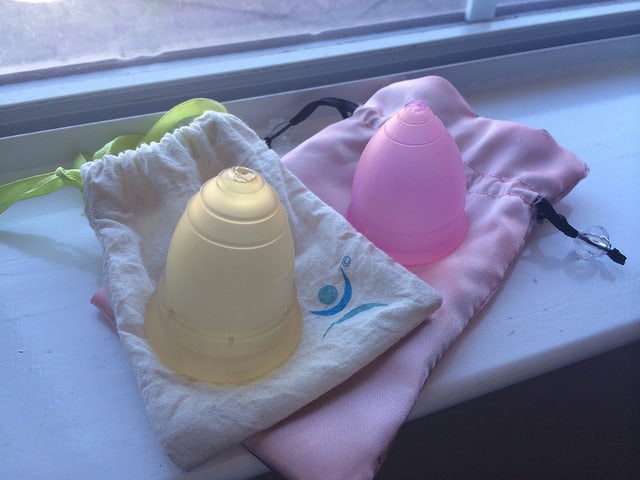These days, more and more people are using menstrual cups instead of tampons. They’re kind of the new product that everyone is talking about. If you don’t know what they are, menstrual cups are bell-shaped cylinders that are made from medical grade silicone, latex, or thermoplastic elastomer. They are designed to be reusable and can last for 5-10 years in most cases.
The way a menstrual cups works is that it collects menstrual fluid. You take it out at regular intervals (12 hours maximum) and empty it into the toilet. You wash the cup with mild soap and water and then reinsert it. Sounds easy? It is, which is why more and more people are using them.
Why should you consider making the switch to a cup from tampons? There are lots of reasons, but I’ll share my top five with you here, including environmental factors, toxins in tampons, risk of TSS, money-saving potential, and ease of use.
Reason #1: They’re Better for the Environment
Plastic waste is a big problem these days. Much of it ends up in the landfill, where it doesn’t really biodegrade, or in the ocean where it’s a disaster for wildlife.
The average person uses 11,000 tampons during a lifetime. With a heavy, and/or long period, it’ll be far more than that. That’s a lot of waste going to the landfill.
In terms of environmental harm, the tampons with plastic applicators are by far the worst. Next are the ones with cardboard applicators. Finally, even the ones without applicators usually come wrapped in little bits of plastic which isn’t biodegradable and often ends up in our oceans.
If you’re going to use tampons, a better option for the environment are organic ones. Most of the best brands are made from non-plastic materials, including the wrappings and packaging. But, even these still create waste that’s going to the landfill. Due to the nature of these products, they can’t be recycled.
Menstrual Cup: A Better Alternative for the Environment
Even better than organic tampons are the very eco-friendly menstrual cups. They are designed to be reusable for up to 10 years and can potentially replace thousands of tampons. Depending on where you live, menstrual cups can often be recycled, unlike with tampons.
Imagine the possibilities if more people made the switch to reusable period products? Our Earth would certainly be a better place! (Also consider period panties and reusable cloth pads).
Energy and Materials for Packing and Transportation
Thousands of tampons vs. a handful of menstrual cups over a lifetime. Think about the energy and raw materials used to create all these products. Then, the fuel it requires to get them from the factory to the store you buy them in.
Clearly, menstrual cups are a much better alternative in this regard.
Reason #2: You Can Reduce your Exposure to Toxic Chemicals
Here’s something that many people don’t know, but should…
Many brands of tampons contain trace amounts of toxic chemicals in them. They mostly come from the pesticides that are used to grow the cotton, but the bleaching process is also quite harmful.
These toxic chemicals pollute the environment, as well as our bodies. There isn’t a lot of this stuff in products, but even small amounts, over time can be detrimental to our health.
Part of the problem is that companies in most countries are required to disclose what’s in these things. For example, in the USA, the FDA (Food and Drug Administration) classifies tampons and sanitary napkins as medical devices. This loophole allows companies to not tell consumers vital information about their products.
Hopefully legislation surrounding this will change. Or, consumers demand change. In the meantime, it just makes sense to use a menstrual cup, which comes without this risk of toxic chemicals.
Stick with a Top-Quality Cup
There are some very cheap menstrual cups that you can find on Amazon for $5-10 USD. They are most often made in China from materials that are not medical grade. You’ll see words like “platinum,” or “food-grade” instead.
These products are not safe to put inside your body because they can degrade very quickly. Then, you’ll have the same problem with toxic chemicals.
Instead, consider using a top quality menstrual cup which you can find online for $20-30 USD. Some of the best brands include the following: Lena Cup, Mooncup, Lunette Cup, Diva Cup, Saalt Cup, Anigan Eva Cup, SckoonCup, Super Jennie, and the Yuuki Cup.
Of these cups, my personal favourite is the Lena Menstrual Cup. It’s very affordable, but has some of the highest user ratings among all menstrual cups on Amazon. It just works well!
Reason #3: Menstrual Cups have a Lower Risk of Toxic Shock Syndrome
The risk of TSS from tampons is actually quite low. This is especially true if you take basic precautions such as changing it frequently enough, and using the lowest absorbency level possible.
However, it does still exist, and when it happens, it’s serious and potentially life-threatening.
What about the risk of Toxic Shock Syndrome with menstrual cups? In theory, it is certainly possible to get TSS from a menstrual cup. It’s possible with anything that you put into your body.
However, there’s only been one reported case of Toxic Shock Syndrome from a menstrual cup to date. It happened because the person cut themselves when inserting the cup at the beginning of their period and then left it in for too long.
It’s clear that the overall risk of TSS from a menstrual cup is lower than with tampons. However, some basic precautions with period cups should be taken, such as:
- Washing your cup well each time you take it out with a mild soap or menstrual cup wash and water
- Wash your hands before handling the cup
- Sterilize your cup between cycles by boiling it in a pot of water for 5 minutes
- Regularly inspect your menstrual cup for signs of deterioration. If you notice any signs that it’s beginning to degrade, stop using it immediately.
Reason #4: You’ll Save Money with a Menstrual Cup
Tampons are expensive! This is especially true if you have a heavy period and need to use an entire box (or two) every single period. The average person spends around $5 USD per month.
Compare this to a menstrual cup. The top-quality ones you should feel safe about putting into your body can be found for $20-30 USD on Amazon. You’ll “break even” in only a few months when compared to tampons. And because they last for years, you’ll save hundreds or even thousands of dollars over your lifetime.
Quick tip: If you use pantyliners or disposable pads, consider making the switch to reusable cloth ones. They have the same money-saving potential that menstrual cups do.
For the full breakdown, be sure to check: Are Menstrual Cups Expensive?
Reason #5: It’s Easier, Kind of
One of the big negatives with menstrual cups is that there can be a pretty steep learning curve to them. It takes most people at least 3-4 cycles to really get the hang of inserting them correctly.
This means that they’ll probably leak at first. Wear a pad for the first few times, and don’t worry too much about it. The vast majority of people do figure it out, so don’t give up too soon.
Once you get past this, there are a number of benefits to switching from tampons to a menstrual cup in terms of convenience.
No More Running to the Store
You’ll love not worrying about running to the store to buy tampons all the time, and worrying about whether or not you’re going to run out. You have one thing, it’s reusable and it’ll always just be there when you need it. So easy!
Great for Heavy Period
The average tampon holds around 5 ml of fluid, while a jumbo one can absorb 10 ml.
Compare this to the average menstrual cup which has room for 30 ml. There are even some high-capacity period cups that hold 40+ ml.
During the night of your heaviest flow, maybe you’ve had the not-so-fun experience of having to get up to deal with your period. Try out a menstrual cup, pair it with a pad in case of overflow and you might actually be able to sleep through the night.
This is also ideal for that long day at the beach, when hiking, or on a long bus ride. No more worries about your tampon leaking and having to deal with it.
Fewer Yeast Infections
There are no conclusive scientific studies about this, but many people report that they experience fewer yeast infections when using a menstrual cup compared to tampons. It might be because tampons dry out your vagina, while menstrual cups do not. Or, it could have something to do with the toxins that are sometimes found in tampons.
Ready to Make the Switch?
You’ll be joining an enlightened group of people who are making a good choice for the environment, their health as well as their bank account balance!
About the Author
Jackie Bolen is a tree-hugging, friend of the Earth who hopes that a reusable feminine hygiene product will one day be found in the hands of every single menstruating person in the world. You can find Jackie on her Eco-Friendly Period Products YouTube Channel.






